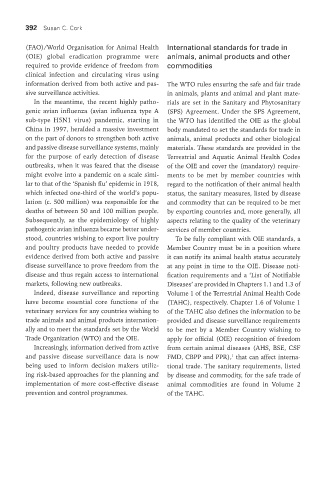Page 455 - The Veterinary Laboratory and Field Manual 3rd Edition
P. 455
392 Susan C. Cork
(FAO)/World Organisation for Animal Health International standards for trade in
(OIE) global eradication programme were animals, animal products and other
required to provide evidence of freedom from commodities
clinical infection and circulating virus using
information derived from both active and pas- The WTO rules ensuring the safe and fair trade
sive surveillance activities. in animals, plants and animal and plant mate-
In the meantime, the recent highly patho- rials are set in the Sanitary and Phytosanitary
genic avian influenza (avian influenza type A (SPS) Agreement. Under the SPS Agreement,
sub-type H5N1 virus) pandemic, starting in the WTO has identified the OIE as the global
China in 1997, heralded a massive investment body mandated to set the standards for trade in
on the part of donors to strengthen both active animals, animal products and other biological
and passive disease surveillance systems, mainly materials. These standards are provided in the
for the purpose of early detection of disease Terrestrial and Aquatic Animal Health Codes
outbreaks, when it was feared that the disease of the OIE and cover the (mandatory) require-
might evolve into a pandemic on a scale simi- ments to be met by member countries with
lar to that of the ‘Spanish flu’ epidemic in 1918, regard to the notification of their animal health
which infected one-third of the world’s popu- status, the sanitary measures, listed by disease
lation (c. 500 million) was responsible for the and commodity that can be required to be met
deaths of between 50 and 100 million people. by exporting countries and, more generally, all
Subsequently, as the epidemiology of highly aspects relating to the quality of the veterinary
pathogenic avian influenza became better under- services of member countries.
stood, countries wishing to export live poultry To be fully compliant with OIE standards, a
and poultry products have needed to provide Member Country must be in a position where
evidence derived from both active and passive it can notify its animal health status accurately
disease surveillance to prove freedom from the at any point in time to the OIE. Disease noti-
disease and thus regain access to international fication requirements and a ‘List of Notifiable
markets, following new outbreaks. Diseases’ are provided in Chapters 1.1 and 1.3 of
Indeed, disease surveillance and reporting Volume 1 of the Terrestrial Animal Health Code
have become essential core functions of the (TAHC), respectively. Chapter 1.6 of Volume 1
veterinary services for any countries wishing to of the TAHC also defines the information to be
trade animals and animal products internation- provided and disease surveillance requirements
ally and to meet the standards set by the World to be met by a Member Country wishing to
Trade Organization (WTO) and the OIE. apply for official (OIE) recognition of freedom
Increasingly, information derived from active from certain animal diseases (AHS, BSE, CSF
and passive disease surveillance data is now FMD, CBPP and PPR), that can affect interna-
1
being used to inform decision makers utiliz- tional trade. The sanitary requirements, listed
ing risk-based approaches for the planning and by disease and commodity, for the safe trade of
implementation of more cost-effective disease animal commodities are found in Volume 2
prevention and control programmes. of the TAHC.
Vet Lab.indb 392 26/03/2019 10:26

